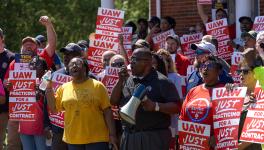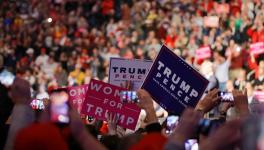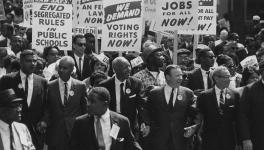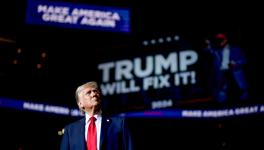Puerto Rico Hurricane: Racial Discrimination by USA

It is now about 10 months after Hurricane Maria hit the US territory of Puerto Rico in the Caribbean in September 2017. The hurricane destroyed hundreds of thousands of homes, brought down electricity and drinking water systems, and communications networks. It also wreaked havoc on health facilities, roads and other infrastructure, much of which has not yet been restored. Estimates have put the total damage caused at over $100 billion (Rs.6,80,000 crores), making it the third highest economic loss due to tropical cyclones in the US since 1900. More than 200,000 residents have moved to mainland USA, chiefly to Miami and other parts of Florida, and are still waiting for conditions to normalise before they even think of returning. The response of the Federal Government led by Donald Trump, and especially of the Federal Emergency Management Agency (FEMA), has been horribly slow and ineffective, if not downright negligent, perhaps even deliberately so.
Officially, the death toll still stands at 64, but detailed household surveys by reputed organisations have estimated fatalities in the several thousands.
You would be forgiven for thinking that this was a disaster in some benighted, corruption-ridden third-world country, not in one of the richest and certainly the most powerful country in the world, the United States of America. But this is indeed the USA, the dark side which reveals itself every now and then from under the cloak of wealth, military might and arrogance. It shows up the seamy sight of the South within the global North, the grinding poverty of segments of the US population and the systemic discrimination against sections which render them perennially marginalised. In Puerto Rico, it also unveils the long history of racist mainland attitudes towards the island and its inhabitants which have prevented it from becoming a full-fledged State, integrated into the USA.
Death toll
The apparently enormous discrepancy between official and other estimates of hurricane-related fatalities may appear incomprehensible. Yet, organisations that conducted surveys have a good reason for arriving at a figure many tens of times higher than the official toll of 64.
Several media outlets had claimed that local and federal authorities were under-reporting fatalities, and projected over 1,000 deaths based on different information gathering exercises. CNN, along with a local NGO called the Centre for Investigative Journalism, had surveyed 112 funeral parlours on the island, about half the total, in the early post-hurricane period and had estimated that 499 fatalities could be hurricane-related. This team in fact has sued the island’s authorities for withholding records pertaining to deaths during that period.
One of the most well-regarded studies, results of which were published in the prestigious New England Journal of Medicine, was by a team of scholars from Harvard University and the Beth Israel Deaconess Medical Center, a teaching hospital of the Harvard Medical School, along with scholars from the University of Colorado and Universities in Puerto Rico. The team conducted a sample household survey in January-February this year. The survey covered 3,299 randomly selected households, which is an admittedly small sample of the total 1.13 million households. Further, since the study enumerates fatalities due to direct or indirect factors, such as delays in getting medical treatment or poor infrastructure, results are subject to a sizeable margin of error.
The report arrived at a fairly wide range of numbers (with 95 per cent confidence level) and reported mid-numbers as per usual practice. As a cross-check, the researchers also compared the number of deaths with numbers during the same period a year ago.
The study estimates that a total of 4,645 deaths (mid-point of 793 and 8,498) could be ascribed to Hurricane Maria. If correct, this would be more than double the fatalities due to the notorious Hurricane Katrina in 2005. Around one-third of the deaths in Puerto Rico had probably occurred due to delays in getting the victims to the hospital or lack of facilities there or in homes as a result of the hurricane. Continued absence of electrical supply, inability to procure essential medicines for chronic ailments, or lack of financial resources, for instance to acquire a ventilator at home, were major factors. Health care disruption due to electricity supply or other infrastructure failure was identified as a major cause of death, as has also been the case after other natural disasters in the US.
The survey itself, and a number of reviews of it, have pointed to the importance of such studies, despite their possible quantitative inaccuracies, in order to get a clearer picture of the effects of natural disasters on the population. Such studies serve a worthy purpose both for the immediate or short-term tasks of disaster management, relief and rehabilitation, and restoration of infrastructure, as well as with regard to risk reduction, preparedness, preventive measures and planning for future disasters. Community-based assessments also help capture deaths or mortality which are usually missed by official death certificates or institutional records.
In Puerto Rico, the Harvard study underlined the immediate and continued “inattention of the U.S. government to the frail infrastructure”. Puerto Rican authorities have not contested the study results, and have appointed their own study whose results are still awaited.
Failures in disaster response
The response of the Trump administration and of FEMA to the disaster wreaked by Hurricane Maria (and Hurricane Irma before it) has been woefully inadequate and shambolic. This did not, however, prevent President Trump from praising FEMA and its boss for “doing a great job”, immediately reminding people about then President George W. Bush praising his FEMA Chief Michael Brown for “doing a heck of a job” after Hurricane Katrina, despite the torrent of criticism for his bungling of relief work. Then too questions were raised whether the federal response would have been better if the affected people in Louisiana had not been predominantly poor and black. In Puerto Rico, this question of racist discrimination has become unavoidable, albeit less loudly articulated than after Katrina.
For many weeks after Hurricane Maria, news channels were telecasting long lines of Puerto Ricans queuing up for drinking water, food and other essentials. E-mails obtained by some mainland media have shown supermarkets in Puerto Rico desperately sending FEMA mails pleading for generators, trucks and fuel to ensure food does not rot and can be reached to the residents cut off due to the damaged roads etc., but finally threw out hundreds of tons of vital provisions when FEMA simply did not respond. FEMA may have spent a lot of money ferrying such supplies as timber, cement etc to rebuild homes, but for months after the hurricane, even basic necessities were in short supply.
The tardy response was in a sharp contrast to the prompt and substantial relief effort in Texas on the US mainland after Hurricane Irma just a few weeks back. A US warship had been sent to Texas with helicopters on board to provide relief, but no such effort was made in Puerto. Even though the island is about 1,000 miles off the US mainland, advance warning of Maria had been available weeks in advance, but no preparations had been made.
National Nurses United, the major union organising nurses in the US, said that volunteer nurses who had rushed to Puerto Rico after Maria “saw residents left to die by a federal response that failed its own American citizens". A planning document accessed my US media revealed that FEMA had relied on local infrastructure and supplies, even though it was common knowledge that these were already in poor condition due to a prolonged financial crisis in Puerto Rico, thus severely hampering relief operations which necessarily had to come from the mainland.
More than 400,000 Puerto Ricans fled the island and moved temporarily to the mainland, chiefly to Miami and other towns in Florida, with around 2,000 families staying in hotels. The US federal government runs a disaster relief programme called Transitional Shelter Assistance (TSA) till the victims can return to reconstructed homes and communities. Yet, while FEMA on the one hand certified that homes were not yet ready in Puerto Rico even as late as July this year, on the other hand, notified islanders staying in hotels that the TSA facility was being withdrawn, essentially throwing them out on the street. It required a federal judge to intervene and order continuation of the TSA saying that FEMA was “knowingly withholding desperately needed support to these marginalised American citizens”. Hurricane Maria victims were also not extended help under the federal Disaster Housing Assistance Programme, under which disaster victims would receive support for rental homes for longer duration rehabilitation as in the case of Katrina, Irma and Sandy.
In the 2017 hurricane season, the US federal government responded with far greater alacrity, vastly greater financial assistance, and much more by way of relief and rehabilitation to Hurricane Harvey which hit Texas and Hurricane Irma which hit Florida than to Hurricane Maria which hit Puerto Rico with greater ferocity and far more damage just a couple of weeks later. Florida received 10 times more meals, 3 times more water, and 20 times more tarpaulins than Puerto Rico, apart from less FEMA manpower, many of whom were trainees or other unprepared staff.
This was justified by President Trump characterising, while on his visit to Puerto Rico soon after the hurricane, that he had been busy attending to “real catastrophes” like Hurricanes Harvey and Irma, and expressed concern that the island’s disaster was “throwing our budget out of whack,” all as he casually tossed paper towels, which he must have thought were truly emergency supplies, to the expectant crowd!
In-built racism
Unfortunately, the unmistakable racist under current has been missed or glossed over even by otherwise liberal or even progressive politicians and media houses in the mainland. Puerto Rico’s history can throw some light.
Puerto Rico is a US territory, not a full-fledged State. Its residents are US citizens, can travel freely within the US, but do not have representation in the US Congress where they are represented by a non-voting resident commissioner, and cannot vote for the president and vice president although they can participate in the primary elections. This anomalous position persists despite numerous efforts by its citizens to rectify it, including several recent referenda.
Puerto Rico was one of Spain’s last remaining colonies when it was invaded by the US in 1898 during the Spanish-American War. Though it failed to gain control of Cuba, the US took over Guam and the Philippines, along with Puerto Rico. Citizenship for islanders came only in 1917, when Puerto Ricans were also bestowed the “right” to serve in the US military during World War I. Even today, Puerto Rico sends more people into military service than Texas or other large states on the mainland. The refusal of the US to grant full statehood to the territory despite this has been a cause of major resentment on the island, recalling the continued segregation and denial of full civil rights to blacks both inside the outside the armed forces till well after World Water II.
In a recent survey, about 50 per cent of mainland Americans did not know that Puerto Ricans are US citizens, free to travel in the US and a US territory. Even after a century of the US rule, islanders are widely perceived as foreigners and, importantly, ethnically different.
A series of Supreme Court decisions between 1901 and 1922 called the Insular Cases drew up a body of new laws as to why the Constitution of the US did not apply to Puerto Rico and the other newly acquired territories. The main justification was that the islanders were “uncivilized” and “alien races.” The body of laws went further than the earlier rulings that blacks were “separate but equal,” which justified racial segregation in the US, and argued that Puerto Rico was not only separate but not equal either. Many of the judges in the Supreme Court were the same in both the cases and, while the case law favouring racial segregation were subsequently overturned, the Insular Cases remain on the books and continue to be relied on by US Courts for matters relating to Puerto Rico! Like in erstwhile colonial rule in Europe and elsewhere, the modern-day US colony of Puerto Rico is kept away from full statehood and its people from full citizenship by the idea that its residents are “lesser races” “incapable of governing themselves.”
Thus sovereignty of the Puerto Rican people does not rest with them, but is vested with mostly white, mostly male representatives in far-away Washington. And it is also thus that, when questioned about their poor response to the disaster caused by Hurricane Maria in Puerto Rico, President Trump and others fall back on centuries-old colonial stereotypes of islanders being “lazy” and “indolent,” and, in Trump’s own words, “wanting everything done for them”.
Get the latest reports & analysis with people's perspective on Protests, movements & deep analytical videos, discussions of the current affairs in your Telegram app. Subscribe to NewsClick's Telegram channel & get Real-Time updates on stories, as they get published on our website.
























